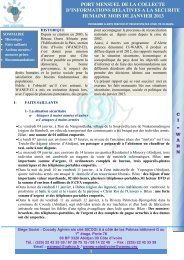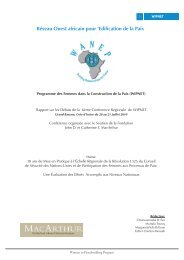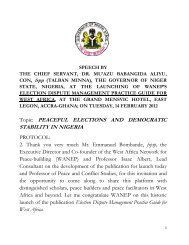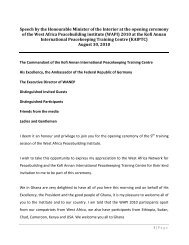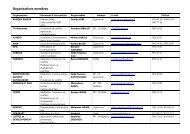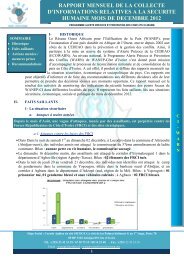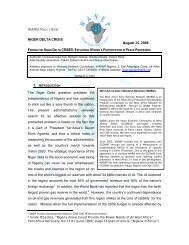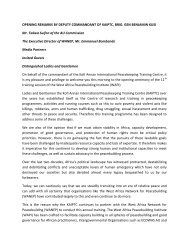DEVELOPMENT AND IMPLEMENTATION of National Action Plans ...
DEVELOPMENT AND IMPLEMENTATION of National Action Plans ...
DEVELOPMENT AND IMPLEMENTATION of National Action Plans ...
You also want an ePaper? Increase the reach of your titles
YUMPU automatically turns print PDFs into web optimized ePapers that Google loves.
••Whatever the approach, the agency coordinating the planning process should have:»»The authority to effectively lead the planning and implementation processes among thedifferent ministries and other collaborating partners;»»Has sufficient government support, resources and authority to generate a documentthat is supported and implemented by all relevant actors.Though Ministry for Gender/Women Affairs has led most <strong>of</strong> the process in developingcountries, they are <strong>of</strong>ten marginalized and underfunded in most governments <strong>of</strong>ten givingrise to beautiful documents on paper that are hardly translated to action. For this reason itmay be expedient to look to the Ministry <strong>of</strong> Defence which may have more resources andauthority to realistically implement NAPs and build strategic alliances across government.Step 4: Plan for PlanningPlan for planning including holding <strong>of</strong> meeting to develop terms <strong>of</strong> reference (TOR) for theTaskforce – the TOR will guide the process <strong>of</strong> developing the NAP. The TOR should include:»»Rationale – why the NAP is being developed;»»Establishment <strong>of</strong> objectives for creating the action plan– both general and specific. Theobjectives should be clear and realistic – SMART (Specific, measurable, attainable, realisticand time bound);»»Strategy/Methodology – this should include the specific steps that will be taken todevelop the NAP and the responsibilities for all actors involved such as the taskforce,consultants, facilitators, etc;»»Expected outcome – <strong>National</strong> <strong>Action</strong> Plan, materials (IEC/BCC), capacity building andawareness raising initiatives;»»Time lines – establishment <strong>of</strong> realistic deadlines for the different steps in the process andthe finished NAP;»»Budget – the cost <strong>of</strong> developing the NAP should be part <strong>of</strong> the TOR. This should includecosts <strong>of</strong> potential consultants, assessments, translations, publication and distribution <strong>of</strong>NAPs, production and distribution <strong>of</strong> IEC/BCC materials, workshops and meetings, etc.Step 5: Identifying Opportunities for Resource MobilizationThe process <strong>of</strong> elaboration <strong>of</strong> NAPs can be seriously constrained by inadequate resources(both human and financial) so ab initio, the team must begin to look for opportunities forraising the required resources. Different sources are mentioned below:»»Internal resources within the government;»»Private Sectors from Corporate Social Responsibilities & Civil Societies;»»External Assistance.••International organizations can support the development <strong>of</strong> NAPs particularly indeveloping countries providing funding and technical support. These will includeUNFPA, UN Women, UNDP, United Nations Peacekeeping Mission (MONUC), EuropeanUnion, etc.13



![English [266KB] - West Africa Network for Peacebuilding](https://img.yumpu.com/50460007/1/184x260/english-266kb-west-africa-network-for-peacebuilding.jpg?quality=85)
